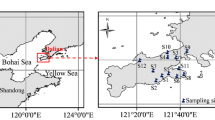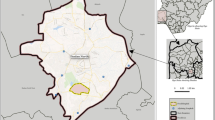Abstract
This study surveyed the hospital wastewater characters focusing on antibiotic contamination in seven hospitals in Bangkok. It detected 19 antibiotics of which the high-frequent detection were quinolones such as ofloxacin + levofloxacin, norfloxacin, ciprofloxacin including sulfamethoxazole. Norfloxacin and ciprofloxacin appeared the highest concentrations of 12.11 and 9.60 μg/L, respectively. Most antibiotic concentrations in the wastewaters of the studied hospitals gave a good correlation (r 2 = 0.77–0.99) to the amount of usage. In this study, batch acute toxicity tests were performed to assess the toxicity of hospital wastewater on mixed liquor, freshwater algae (Chlorella vulgaris and Scenedesmus quadricauda), and microcrustacean (Moina macrocopa). The hospital wastewaters could inhibit the mixed liquor growth and gave similar toxic levels among test species: algae and microcrustacean (9.81–13.63 and 2.62–3.09 TU, respectively). The conventional activated sludge (CAS) and rotating biological contactor (RBC) could remove fluoroquinolones and tetracycline via biomass adsorption. After treatment, most of treatment could reduce the toxicity. Nevertheless, the effluent gave slight toxicity on some test species which might be caused from chlorination and a common toxicant (NH3-N).

Similar content being viewed by others
References
Andrieu M, Rico A, Phu TM, Huong DTT, Phuong NT, Brink PJVD (2015) Ecological risk assessment of the antibiotic enrofloxacin applied to Pangasius catfish farms in the Mekong Delta, Vietnam. Chemosphere 119:407–414
APHA (2012) Standard methods for examination of water and wastewater 22nd edition. American Public Health Association, Washington DC
Batchu SR, Panditi VR, O’Shea KE, Gardinali PR (2014) Photodegradation of antibiotics under simulated solar radiation: implications for their environmental fate. Sci Total Environ 470–471:299–310
Boillot C, Bazin C, Tissot-Gerraz F, Droguet J, Perraud M, Cetre JC, Trepo D, Perrodin Y (2008) Daily physico-chemical and ecotoxicological fluctuations of a hospital effluent. Sci Total Environ 403:113–129
Carucci A, Cappai G, Piredda M (2006) Biodegradability and toxicity of pharmaceuticals in biological wastewater treatment plants. J Environ Sci Health Environ Sci Eng 41(9):1831–1842
Collos Y, Harrison PJ (2014) Acclimation and toxicity of high ammonium concentrations to unicellular algae. Mar Pollut Bull 80:8–23
Dorival-Garcia N, Zafra-Gomez A, Navalon A, Gonzalez J, Vilchez JL (2013) Removal of quinolone antibiotics from wastewaters by sorption and biological degradation in laboratory-scale membrane bioreactors. Sci Total Environ 442:317–328
Emmanuel E, Keck G, Blanchardb J, Vermande P, Perrodina Y (2004) Toxicological effects of disinfections using sodium hypochlorite on aquatic organisms and its contribution to AOX formation in hospital wastewater. Environ Int 30:891–900
Emmanuel E, Perrodin Y, Keck G, Blanchard JM, Vermande P (2005) Ecotoxicological risk assessment of hospital wastewater: a proposed framework for raw effluents discharging into urban sewer network. J Hazard Mater 117:1–11
EPA (2007) Pharmaceuticals and personal care product in water, soil, sediment and biosolids by HPLC/MS/MS. Method 1694. U.S. EPA, Washington DC
Fischer HW, Ulbrich S, Pittauerova D, Hettwig B (2009) Medical radioisotopes in the environment-following the pathway from patient to river sediment. J Environ Radioact 100:1079–1085
Ji K, Kim S, Han S, Seo J, Lee S, Park Y, Choi K, Kho Y, Kim P, Park J, Choi K (2012) Risk assessment of chlortetracycline, oxytetracycline, sulfamethazine, sulfathiazole, and erythromycin in aquatic environment: are the current environmental concentrations safe? Ecotoxicology 21:2031–2050
Jolibois B, Guerber M, Vassal S (2002) Glutaraldehyde in hospital wastewater. Arch Environ Contam Toxicol 42:137–144
Kummerer K, Henninger A (2003) Promoting resistance by the emission of antibiotics from hospitals and households into effluent. Clin Microbiol Infect 9:1203–1214
Kummerer K (2004) Resistance in the environment. J Antimicrob Chemother 54:311–320
Kummerer K (2009) Antibiotics in the aquatic environment—a review—part I. Chemosphere 75:417–434
Lin AU, Tsai Y (2009) Occurrence of pharmaceuticals in Taiwan’s surface waters: impact of waste streams from hospitals and pharmaceutical production facilities. Sci Total Environ 407:3793–3802
Metcalf & Eddy, Inc (2004) Wastewater engineering: treatment and reuse. 4th edition, revised by George Tchobanoglous, Franklin L. Burton, and H. DavidStensel. McGraw Hill, New York
Nandini S, Aguilera-Lara D, Sarma SSS, Ramirez-Garcia P (2004) The ability of selected cladoceran spicies to utilize domestic wastewaters in Mexico City. J Environ Manag 71:59–65
Nguyen TV, Le PV, Le CH, Weintraub A (2005) Antibiotic resistance in diarrheagenic Escherichia coli and Shigella strains isolated from children in Hanoi, Vietnam. Antimicrob Agents Chemother 49:816–819
Papadimitriou C, Palaska G, Lazaridou M, Samaras P, Sakellaropoulos GP (2007) The effects of toxic substances on the activated sludge microfauna. Desalination 211:177–191
Park S (2014) The selective use of chlorine to inhibit algal predators and avoid pond crashes for the algae-biodiesel industry. Master thesis, Georgia Institute of Technology
Petinaki E, Guerin-Faublee V, Pichereau V, Villers C, Achard A, Malbruny B, Leclercq R (2008) Lincomycin resistance gene lnu(D) in Streptococcus uberis. Antimicrob Agents Chemother 52:626–630
Radjenovic J, Matosic M, Mijatovic I, Petrovic M, Barcelo D (2008) Membrane bioreactor (MBR) as an advanced wastewater treatment technology. Handb Environ Chem 5:37–101
Santos LHMLM, Gros M, Rodriguez-Mozaz S, Delerue-Matos C, Pena A, Barcelo D, Montenegro MCBSM (2013) Contribution of hospital effluents to the load of pharmaceuticals in urban wastewaters: identification of ecologically relevant pharmaceuticals. Sci Total Environ 461–462:302–316
Sawant AA, Hegde NV, Straley BA, Donaldson SC, Love BC, Knabel SJ, Jayarao BM (2007) Antimicrobial-resistant enteric bacteria from dairy cattle. Appl Environ Microbiol 73:156–163
Schroder HF, Tambosi JL, Sena RF, Moreira RFPM, Jose HJ, Pinnekamp J (2012) The removal and degradation of pharmaceutical compounds during membrane bioreactor treatment. Water Sci Technol 65:833–839
Souza SML, Vasconcelos EC, Dziedzic M, Oliveira CMR (2009) Environmental risk assessment of antibiotics: an intensive care unit analysis. Chemosphere 77:962–967
Ternes TA, Joss A (2006) Human pharmaceuticals, hormones and fragrances. The challenge of micropollutances in urban water management. IWA Publishing, London
Theeppharaksapan S, Chiemchaisri C, Chiemchaisri W, Yamamoto K (2011) Removal of pollutants and reduction of bio-toxicity in full scale chemical coagulation and reverse osmosis leachate treatment system. Bioresour Technol 102:5381–5388
Verlicchi P, Al Aukidy M, Galletti A, Petrovic M, Barcelo D (2012) Hospital effluent: investigation of the concentrations and distribution of pharmaceuticals and environmental risk assessment. Sci Total Environ 430:109–118
Acknowledgments
This research was financially supported by the ASEAN University Network/Southeast Asia Engineering Education Development Network (AUN/SEED-Net) and Kasetsart University Research and Development (KURDI) grant no. S-K 4.56.
Compliance with ethical standards
The authors of this manuscript would like to declare the following statements in compliance with ethical standards required by the journal:
This manuscript was developed based on our original research work as a single piece of work, and it has not been submitted to other journals for publication simultaneously.
The manuscript has not been published previously.
All co-authors of this manuscript have contributed to this work and agreed to the submission of this manuscript for publication in Environmental Science and Pollution Research Journal.
Conflict of interest
The authors declare that they have no competing interests.
Author information
Authors and Affiliations
Corresponding author
Additional information
Responsible editor: Philippe Garrigues
Rights and permissions
About this article
Cite this article
Hamjinda, N.S., Chiemchaisri, W., Watanabe, T. et al. Toxicological assessment of hospital wastewater in different treatment processes. Environ Sci Pollut Res 25, 7271–7279 (2018). https://doi.org/10.1007/s11356-015-4812-0
Received:
Accepted:
Published:
Issue Date:
DOI: https://doi.org/10.1007/s11356-015-4812-0




